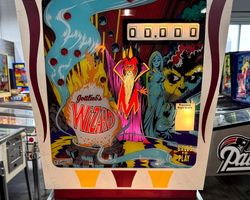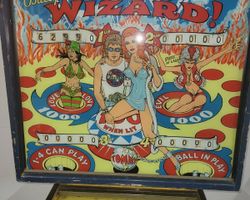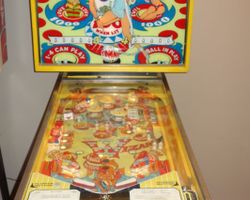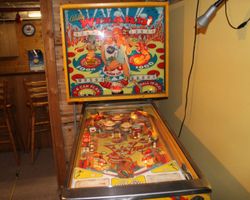Wizard

Average Prices: USD $400 to $1,000
Produced: December, 1971
Machine Type: Electro-mechanical
Players: 1
Design by: Ed Krynski
Art by: Gordon Morison
The year 1971 saw D. Gottlieb & Co. release a distinctive electro-mechanical (EM) pinball machine known as Wizard. This machine stands as an intriguing example of early 1970s pinball design, known for its unique playfield and challenging gameplay. The machine, designated as Model Number 324it, indicates its nature as the Italian market version of Gottlieb’s domestic release, Magic Wizard. Both titles shared the same core design and gameplay, with Wizard becoming particularly notable due to its relative scarcity.
The creative forces behind Wizard were Ed Krynski, responsible for the game’s design, and Gordon Morison, who lent his artistic talents to the machine’s visual presentation. Krynski, a prolific designer for Gottlieb, was known for crafting layouts that offered both strategic depth and accessible fun. Morison’s artwork for Wizard enveloped the machine in a theme of fantasy, myth, and legend, featuring mystical figures and vibrant, ethereal landscapes that transport the player into its enchanted world. The release date in December 1971 positioned Wizard in a transitional period for pinball, just before the widespread adoption of solid-state electronics, making it a robust example of peak EM technology. While specific production numbers for the original 1971 run are not widely publicized, it is understood that Wizard was produced in extremely limited quantities, contributing significantly to its rarity and desirability among collectors in later decades.
Signature Features and Design
Wizard's distinctiveness begins with its artistic execution. Gordon Morison’s artwork is a standout element, garnering consistent praise for its captivating detail and vibrant color palette. The fantasy theme permeates the backglass and playfield, creating an immersive visual experience that draws players into the game’s mythical narrative.
Mechanically, one of Wizard's most defining characteristics is its unconventional playfield design. Unlike many machines of its era, Wizard lacks slingshots, a feature that profoundly impacts ball movement and player strategy. This omission forces players to rely more heavily on precise flipper work and nudging skills to control the ball. Complementing this is the inclusion of four pop bumpers, positioned strategically on the lower half of the playfield. While these bumpers introduce chaotic elements and scoring opportunities, their proximity to the outlanes also presents a constant risk of unexpected drains.
A notable feature for an EM machine of its time, Wizard was designed with operator-adjustable gameplay, allowing the machine to be set for either add-a-ball play or a standard five-ball game. The add-a-ball variant rewards specific achievements during gameplay with additional balls, extending play sessions and amplifying the challenge. The machine’s sound package, comprising three chimes and a knocker, provides crisp, satisfying auditory feedback for score accumulation and significant events, maintaining the classic EM arcade atmosphere. Furthermore, Wizard machines are known for their robust construction, reflecting Gottlieb’s reputation for building durable and reliable pinball tables.
Playfield and Mechanics
The playfield of Wizard offers a layout that, while appearing straightforward, demands meticulous execution from the player. At its foundation are two flippers, positioned at the bottom of the playfield, controlling the ball’s trajectory. The core objective revolves around a set of eleven standup targets spread across the playfield. These targets are central to scoring and advancing game objectives, requiring accurate shots from both flippers. The absence of traditional ramps or captive balls means that ball flow relies heavily on the interaction with these targets and the four pop bumpers.
The design philosophy behind Wizard's playfield emphasizes precision and ball control. Unlike games that might offer extensive ramp combos or complex multi-level play, Wizard focuses on singular, well-aimed shots and adept ball manipulation. The lower quadrant of the playfield is dominated by the four pop bumpers, which, while capable of driving up scores, also present a significant hazard. Balls caroming off these bumpers can easily find their way into the outlanes or down the center drain if not managed with swift nudges or precise flipper cradles.
A key strategic element is the "bullseye" target, which, when hit, resets the bank of standup targets. This creates a cyclical gameplay loop where players aim to clear the targets, then reset them for further scoring opportunities. The artwork on the playfield, executed by Gordon Morison, seamlessly integrates the fantasy theme with the game’s mechanics. Mythical creatures and enchanted landscapes adorn the surface, guiding the eye towards key targets and features. The lighting, typical for an EM machine, utilizes incandescent bulbs to illuminate scoring areas and targets, contributing to the machine’s classic aesthetic.
Gameplay Dynamics
Wizard's gameplay dynamics are characterized by their challenging yet accessible nature, rewarding skill over complexity. The primary objective is to strategically hit the eleven standup targets located throughout the playfield. Each successful hit contributes to the player's score and progresses towards potential bonus objectives. The game's rule set encourages a methodical approach, requiring players to clear specific targets to advance.
A distinguishing gameplay mechanic is the interaction with the "bullseye" target. Hitting this target not only scores points but also resets the bank of eleven standup targets, allowing players to attempt to clear them again for subsequent scoring and potentially activating add-a-ball opportunities, depending on the operator's settings. This reset mechanism ensures a continuous challenge and prevents the game from becoming stagnant once targets are cleared.
Wizard is highly unforgiving, particularly regarding ball drains. Players quickly learn that precise plunging is paramount, as a poorly aimed initial shot can lead directly to the center drain. Similarly, attempting to reset the standup targets without a controlled ball can often result in a "same time down the drain" scenario, highlighting the game's demand for strategic timing. The pop bumpers, while offering score boosts, are a dual-edged sword; their position near the bottom of the playfield means they can unpredictably send the ball towards the outlanes.
The game is widely regarded as an exceptional tool for developing fundamental pinball skills. Its mirrored playfield layout, where shots on one side are mirrored on the other, necessitates proficiency with both the left and right flippers. More significantly, Wizard is a master class in nudging. Players who lack expert nudging skills will find the game brutal and short-lived. Conversely, those who master nudging can use the chaotic energy of the pop bumpers and the unpredictable bounces to their advantage, guiding the ball away from danger and towards scoring opportunities. This demanding nature creates an addictive "one more game" appeal, as players continuously strive to improve their technique and overcome the machine’s inherent difficulty.
Reception and Legacy
Wizard by Gottlieb holds a unique and esteemed position within the pinball community, despite its scarcity. Its reception has been overwhelmingly positive, with many enthusiasts considering it one of the finest electro-mechanical pinball machines ever produced. The primary strength cited by players is its phenomenal artwork, a testament to Gordon Morison's talent, which creates an enduring visual appeal. The game’s challenging yet straightforward rule set is also frequently praised, offering a satisfying depth without unnecessary complexity. Players appreciate that there are numerous targets and objectives to pursue, ensuring varied gameplay even with a relatively simple layout.
The robust construction of Wizard machines is another widely acknowledged strength, reflecting Gottlieb's reputation for durability. This contributes to the machine's longevity and reinforces its status as a well-engineered piece of equipment. Perhaps its most compelling attribute is its ability to foster and test player skill. Wizard is consistently cited as an excellent machine for honing nudging abilities. While this can be a double-edged sword, as the game can be unforgiving to those with imprecise technique, it ultimately makes mastering Wizard a significant accomplishment. The game's capacity to challenge even the most experienced players further solidifies its reputation as a true test of pinball prowess.
However, Wizard is not without its acknowledged drawbacks, primarily revolving around its difficulty and extreme rarity. The machine demands precise plunging, with misfires often resulting in quick drains. The lower pop bumpers, while contributing to scoring, are also a frequent cause of unexpected outlane drains, demanding constant vigilance. The most significant barrier to enjoying Wizard for many is its profound scarcity. Produced in very limited quantities, finding an original machine is exceptionally difficult, and those who own one are rarely inclined to part with it. This scarcity drives its estimated value significantly higher than many other EM machines.
Despite its limited availability, Wizard's legacy is secure within pinball history. It is frequently discussed as a benchmark for demanding EM gameplay, demonstrating that a simple layout, combined with a precise rule set and challenging ball physics, can create a deeply rewarding experience. Its influence lies in its enduring appeal as a "player's game," a machine that prioritizes skill development and mastery over flashy features. Wizard stands as a testament to the depth and longevity possible within electro-mechanical design, continuing to captivate and challenge those fortunate enough to encounter it.
Sponsored Links
 Ebay Listings
Ebay Listings
 Auction Results
Auction Results
| Cost | Location | Date |
|---|---|---|
| USD $4,500 |  Massachusetts, United States Massachusetts, United States |
17 April, 2025 |
| USD $3,500 |  Missouri, United States Missouri, United States |
11 January, 2023 |
| USD $286 |  West Virginia, United States West Virginia, United States |
22 June, 2021 |
| USD $1,450 |  Michigan, United States Michigan, United States |
21 November, 2018 |
| EUR €403 |  Baden-Württemberg, Germany Baden-Württemberg, Germany |
23 March, 2014 |
| EUR €401 |  Nordrhein-Westfalen, Germany Nordrhein-Westfalen, Germany |
17 February, 2014 |
| USD $1,000 |  North Carolina, United States North Carolina, United States |
18 June, 2010 |
| USD $750 |  New York, United States New York, United States |
11 May, 2010 |
| USD $485 |  United States United States |
23 March, 2010 |
| USD $1,250 |  New York, United States New York, United States |
04 December, 2009 |


Private Policy · Search Website · Contact Us
As an eBay Partner, we may earn a commission from qualifying purchases made through links on this site, at no additional cost to you.
All trademarks and copyrighted materials remain property of their respective owners. All other content copyright 2007 - 2025 Pinpedia.





